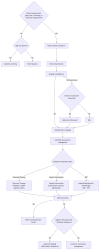Endometriosis and Infertility: Gynecological Examination Practical Guide
- PMID: 40142712
- PMCID: PMC11943251
- DOI: 10.3390/jcm14061904
Endometriosis and Infertility: Gynecological Examination Practical Guide
Abstract
Endometriosis, a prevalent gynecological condition affecting 10-15% of reproductive-age women, involves the growth of endometrial-like tissue outside the uterine cavity. This chronic inflammatory disease can significantly impact fertility by disrupting ovulation, tubal transport, and implantation. Clinical manifestations vary widely, ranging from asymptomatic cases to severe pelvic pain, dysmenorrhea, and dyspareunia. Accurate diagnosis remains challenging, often requiring a combination of patient history, clinical examination, and imaging studies. This paper will discuss the clinical approach to endometriosis during a first-line gynecological appointment, focusing on patient history, including detailed assessment of menstrual, pelvic, and bowel symptoms, and clinical examination; thorough gynecological examination, including abdominal and pelvic palpation, speculum examination, and bimanual examination; imaging evaluation (particularly of the role of ultrasound in identifying and characterizing endometriotic lesions, including the use of the #ENZIAN classification for deep infiltrating endometriosis and evaluation of fertility impact); and discussion of the Endometriosis Fertility Index (EFI) as a tool for assessing fertility potential. This comprehensive approach aims to guide clinicians in identifying and managing endometriosis effectively, improving patient outcomes and optimizing fertility management strategies. Methods: A literature search for suitable articles published from January 1974 to 2024 in the English language was performed using PubMed. Results: Endometriosis is associated with infertility rates ranging from 20% to 68%, with mechanisms including pelvic adhesions, chronic inflammation, and immune dysregulation. The revised American Society for Reproductive Medicine (rASRM) classification and #ENZIAN classification were identified as essential tools for staging and characterizing the disease. Transvaginal ultrasound (TVS) demonstrated high diagnostic accuracy for deep infiltrating endometriosis, with a sensitivity of up to 96% and specificity of 99%. EFI emerged as a valuable predictor of natural conception post-surgery. Additionally, the review underscores the frequent co-occurrence of adenomyosis in women with endometriosis, which may further compromise fertility. Despite advancements in imaging techniques and classification systems, the variability in symptom presentation and disease progression continues to challenge early diagnosis and effective management. Conclusions: Endometriosis is a prevalent gynecological condition affecting women of reproductive age and is associated with infertility. This paper describes the diagnostic approach to endometriosis during a first-line gynecological appointment, focusing on clinical history, physical examination, and the role of imaging, particularly ultrasound, in identifying and characterizing endometriosis lesions. The adoption of standardized classification systems such as #ENZIAN and EFI enhances disease staging and fertility prognosis, allowing for tailored treatment strategies. Despite improvements in non-invasive diagnostic methods, challenges persist in correlating symptom severity with disease extent, necessitating continued research into biomarkers and novel imaging techniques. Additionally, the frequent coexistence of adenomyosis further complicates fertility outcomes, underscoring the need for comprehensive management strategies. Further research is needed to enhance early detection strategies and optimize fertility preservation techniques for affected women.
Keywords: endometriosis; examination; infertility.
Conflict of interest statement
The authors declare no conflict of interest.
Figures
Similar articles
-
Accuracy of sonography for non-invasive detection of ovarian and deep endometriosis using #Enzian classification: prospective multicenter diagnostic accuracy study.Ultrasound Obstet Gynecol. 2022 Mar;59(3):385-391. doi: 10.1002/uog.24833. Ultrasound Obstet Gynecol. 2022. PMID: 34919760
-
Diagnosing adenomyosis: an integrated clinical and imaging approach.Hum Reprod Update. 2020 Apr 15;26(3):392-411. doi: 10.1093/humupd/dmz049. Hum Reprod Update. 2020. PMID: 32097456 Review.
-
Surgical treatment of deep endometriosis with adenomyosis externa: a challenging case in an infertile woman.Fertil Steril. 2021 Apr;115(4):1084-1086. doi: 10.1016/j.fertnstert.2020.11.004. Epub 2021 Mar 6. Fertil Steril. 2021. PMID: 33750620
-
Estimation of the Endometriosis Fertility Index prior to operative laparoscopy.Hum Reprod. 2021 Feb 18;36(3):636-646. doi: 10.1093/humrep/deaa346. Hum Reprod. 2021. PMID: 33367865
-
Expert opinion on the use of transvaginal sonography for presurgical staging and classification of endometriosis.Arch Gynecol Obstet. 2023 Jan;307(1):5-19. doi: 10.1007/s00404-022-06766-z. Epub 2022 Nov 11. Arch Gynecol Obstet. 2023. PMID: 36367580 Free PMC article. Review.
Cited by
-
Correlation between Castelli risk index-I and female infertility: A cross-sectional study.Lipids Health Dis. 2025 Jun 3;24(1):200. doi: 10.1186/s12944-025-02617-3. Lipids Health Dis. 2025. PMID: 40462095 Free PMC article.
References
-
- Ferrell K., Rohlfs A., Hansen K., Von Wald T. Endometriosis and Infertility. SD Med. 2020;73:350–355. - PubMed
-
- Lhuillery D. Endométriose: Diagnostic et Prise en Charge. Elsevier Masson; Issy-les-Moulineaux, France: 2020.
Publication types
LinkOut - more resources
Full Text Sources





